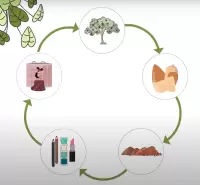Reducing Corporate Carbon Footprint: Essential Strategies and Benefits
What Is the Carbon Footprint?
The concept of carbon footprint (or CO2 footprint) is complex, especially because it is determined by countless factors, most of which go beyond an organization's control. We believe that, at first, it is crucial for organizations to understand the scope of carbon footprint or CO2 footprint. The term commonly describes the total amount of greenhouse gases–primarily carbon dioxide and methane– which are released into the atmosphere as a result of activities by a certain entity, be it an individual, company, or even a country.
What Are the Causes of Carbon Footprint?
In a business context, the causes of carbon footprint refer primarily to the emissions resulting from all of their operations, which may include manufacturing processes, energy use in buildings, fuels used for transportation. These are referred to the Scope 1 Emissions, i.e. emissions being caused directly by and within an organization. To understand their real impact on the environment, however, organizations should take a more holistic approach. Holistic should mean taking into consideration all upstream and downstream processes associated with a product or service. The resulting CO2 emissions are the so-called Scope 2 and Scope 3 Emissions. So what exactly do they comprise?
- Scope 2 Emissions refer to all indirect emissions, i.e. emissions generated through goods and services that an organization uses or purchases. For example, the fuel burnt to produce the electricity consumed by a company to manufacture a product. Scope 3 Emissions cover all emissions generated by third parties that are part of a product's value chain. They include, for instance, emissions related to products a company purchases (such as packaging), logistics to deliver goods to the end user, and also emissions related to the use and disposal of the product. In short, the entire value chain, covering raw materials and end-of-life disposal of a product.
The size of a company’s CO2 footprint often becomes a deciding factor in stakeholder viewpoints and customer choices. Furthermore, many governments worldwide are implementing policies that require or incentivize businesses to decrease their carbon footprints, making it a regulatory and financial concern.
Understanding the full scope of their carbon footprint allows businesses to implement sustainable practices that will actually reduce their greenhouse gas emissions. This is beneficial both from an environmental respect as well as from a public relations perspective. By tackling their carbon footprint head on, corporations demonstrate their commitment to sustainable development and to preserving the planet for future generations.
How to Calculate Carbon Footprint
As companies increasingly become aware of the environmental impact of their operations, the notion of calculating a carbon footprint has grown in importance. This figure, expressed in tons or kg of CO2 equivalent, represents the full environmental impact a firm has in terms of greenhouse gas emissions. Through comprehensive carbon accounting, businesses can quantify their carbon emissions and take concrete actions towards sustainability.
There are multiple aspects to consider in the evaluation of a company’s corporate carbon footprint or product carbon footprint. These include direct emissions from owned or controlled sources, indirect emissions from the generation of purchased energy, and all other indirect emissions that occur in the value chain of the firm's goods and services.
To accurately compute a carbon footprint, the data gathered must be complete, consistent and transparent. Moreover, it is crucial for business entities to employ unified metrics and standards in their calculations to ensure comparability. Tools such as the Greenhouse Gas Protocol, a widely used international accounting tool, set the global standard for how to measure, manage, and report these emissions.
In conclusion, comprehensively calculating a CO2 footprint not only enables corporations to comply with regulatory requirements, but also allows them to devise strategic measures to reduce emissions, enhance sustainability, and demonstrate responsibility to consumers and shareholders alike.
How Can We Reduce Our Carbon Footprint?
Decreasing the environmental impact and becoming environmentally responsible is a topic that corporations must address seriously. Currently, a significant concern is the reduction of carbon footprints, the total amount of greenhouse gases that is directly or indirectly caused by an individual, organization, event or product. Businesses have a pivotal role to play in addressing this global issue.
Creating a comprehensive strategy for mitigating carbon emissions is critical for corporations to show social responsibility and stay aligned with international environmental standards. This involves reducing energy consumption, investing in renewable energy, improving waste management techniques and endorsing green transport, etc.
Reducing energy use in buildings can significantly lower a business's greenhouse gas emissions, e. g. with natural insulation materials. Strategies could include installing energy-efficient equipment, using natural light, and investing in renewable energy sources such as solar or wind power. Green transport options, like electric vehicles and bike schemes for employees, can also contribute to sustainability efforts.
Responsible waste management is another crucial factor. This includes reducing, recycling, and repurposing waste, thereby minimizing the amount of waste that goes to landfill, which reduces the associated carbon emissions.
BioPowder's Approach to Carbon Footprint Monitoring
BioPowder is an organization centered around upcycling of agricultural by-products. By transforming olive stones, almond shells, apricot stones and other side-streams into micro-powders, our core business is waste reduction. Realistically speaking, any industrial or economic activity generates some sort of emissions, at least indirectly due to the utilities consumed. This is a fact, and needs to be considered before making any statements about alleged carbon neutrality or even a negative corporate carbon footprint.
Our business can be broken down into upstream, in-house, and downstream activities. Upstream means any activity related to by-product procurement, i.e. all the logistics associated with the purchase and collection of our input materials. Specifically, we source olive stones and all other shells within a maximum radius of 500 km, i.e. locally in Southern Spain, or Morocco in case of the organic argan shells. The upstream emissions related to procurement (Scope 3 Emissions) are mainly associated with transport logistics, and to a minor extent reusable packaging.
When it comes to in-house emissions, the lion's share of our CO2 emissions is indirectly caused by the consumed electricity. The equipment we use includes dryers, mills/grinders, separators, packing lines and accessories. Our corporate carbon footprint calculation is based on the output capacity of the factory equipment and the required amount of electricity to achieve such capacity. Then, the result can be broken down into the CO2 emissions equivalent (kg) per kg of micronized powder.
In Spain, approximately 43 % of the available electric power currently comes from renewable sources. Most calculation methods and tools rate the CO2 emissions equivalent per kwh of power from renewable sources as zero. It remains to be seen how the percentage of ecologically produced electricity will increase over time.
Downstream emissions at BioPowder are mainly due to purchased consumables and materials as well as shipment logistics. In specific terms, purchased materials are packaging items, wooden pallets, pallet boxes and a number of required accessories, also for quality assurance and lab work. To quantify the CO2 emissions equivalent for those items, we depend on information from the respective suppliers. We can doubtlessly say that we have chosen our suppliers carefully and based on the following aspects:
- Product quality, but also
- Proximity to our factory, hence local manufacturing presence
- Content of recycled material: where possible, our packaging is made from recycled PE or paper. Pallets and pallet boxes are sourced second hand, whenever possible.
The logistics necessary to deliver our finished powders to customers can vary significantly. And so does the associated product's carbon footprint. We offer shipment to nearly any destination worldwide and use multimodal freight. Priority is given to truck freight for deliveries within Europe and container freight for overseas exports. Airfreight is used in exceptional cases, i.e. for countries where sea freight is not available or not a timely enough option. As a result, the product carbon footprint of an airfreight delivery to Australia can be over 10 times as high as a truck delivery within the EU. Calculations therefore need to be made on a case-by-case basis in order to be real for a specific customer scenario.
One might assume that, based on the above, the product carbon footprint of BioPowder additives is comparable to the one of products from conventional, i.e. neither recycled nor upcycled, sources. Besides, all CO2 emissions equivalents summed up are likely to produce a figure that is far from carbon neutral. So what makes BioPowder products more attractive from a product carbon footprint perspective? The answer is: carbon capture.
Carbon capture refers to the amount of CO2 that is removed from the atmosphere in connection with an economic activity. In case of BioPowder, evidence suggests that significant carbon capture takes place within the olive and fruit processing ecosystems. Recognized industry associations such as the International Olive Council have found that the olive tree captures around 10 kg of CO2 per litre of olive oil. A major percentage of the absorbed carbon is stored in the olive stone, a lignocellulosic material with a carbon content of 45-50 %.
By upcycling the olive stones, we make this bio-carbon available to create end products with a reduced product carbon footprint. Carbon capture can be a way to achieve net zero or even negative carbon emissions values. Especially in cases where plant-based raw materials compete with those of mineral or synthetic origin, this is a unique selling point (USP) not to be neglected.

Overview of production stages of olive oil by-products relevant for carbon footprint calculations
Conclusion
In the business world, the evolution towards sustainability is no longer just a buzz word, but a necessity for long-term viability and success of companies. The concept of a “static” carbon footprint figure, as suggested by a simple carbon footprint calculator and certain benchmarks, should be viewed critically, because business is subject to constant change. CO2 emissions and carbon footprint monitoring is consequently an ongoing process that requires regular review and adjustment, particularly when considering Scope 2 and 3 Emissions that are beyond an organization's immediate control.
Considering and monitoring a company's carbon footprint as part of everyday business decisions does not only help mitigate the organization's environmental impact, but also builds its reputation as a responsible and forward-thinking organization. Consumers and stakeholders are progressively more concerned about the environment and showing a commitment to reducing a company's carbon emissions can contribute to a stronger brand image, potential cost reductions (think carbon credits), and better risk management.
At BioPowder, we are eager to improve and to learn in order to keep our corporate carbon footprint minimal. Environmental investments, e.g. in even more energy efficient production technologies, are high up on our agenda. Besides, our focus is long-term partnerships with local suppliers and international customers, partners and logistics providers. We believe that choosing environmentally responsible partners can help us pursue a true cradle-to-cradle approach to CO2 footprint monitoring, involving all aspects from by-product harvesting to the creation of innovative, bio-based end products.
Supporting sources:
- All
- Industry Trends
- Biodegradable Packaging Materials
- News
- Biodegradable Alternatives to Microplastic
- Embracing Circular Economy: Profitable Sustainability for Modern Companies
- Olive Stones or Walnut Shells? Pros and Cons in a “Nutshell”
- Glossary
- BioPowder Launches Application Lab For Bio-Based Coating Formulations




